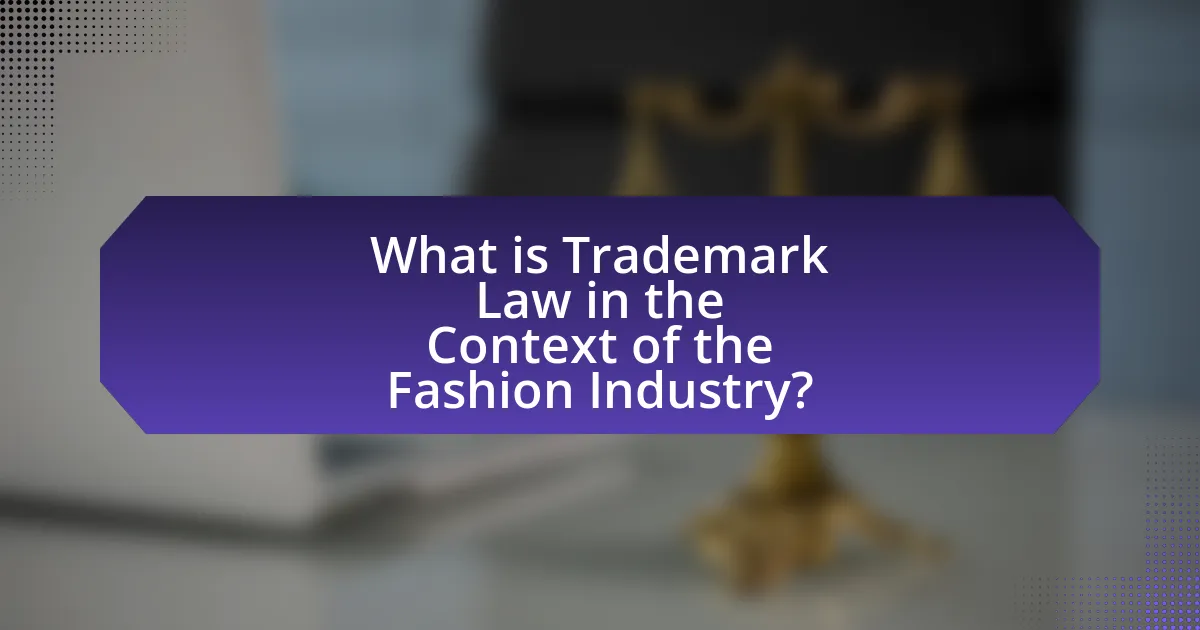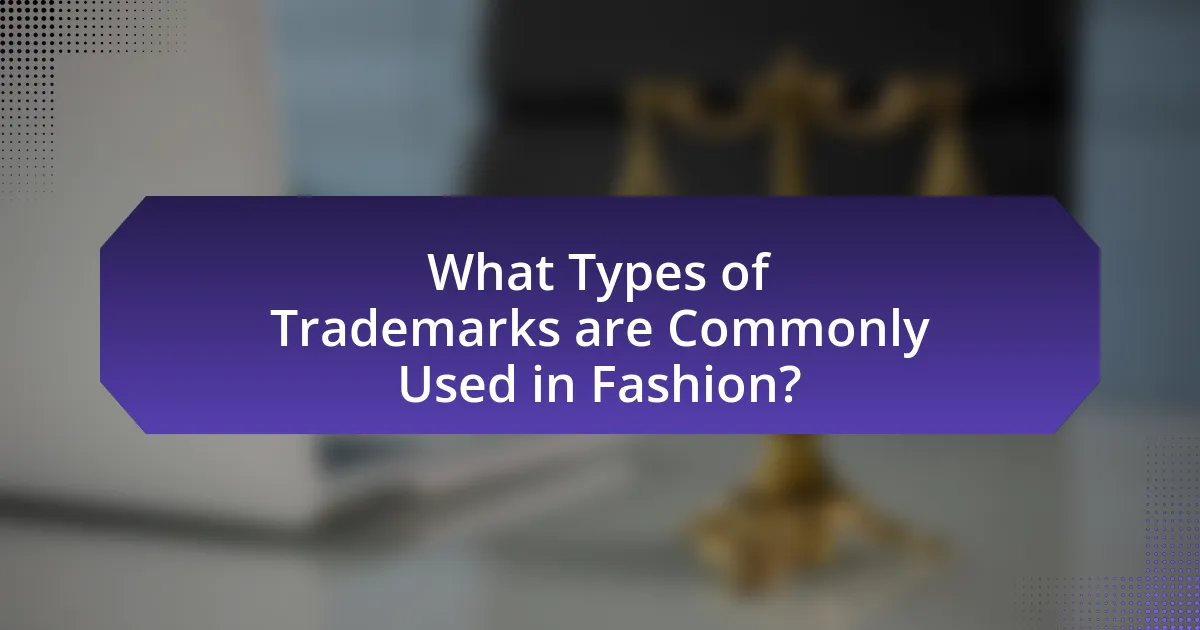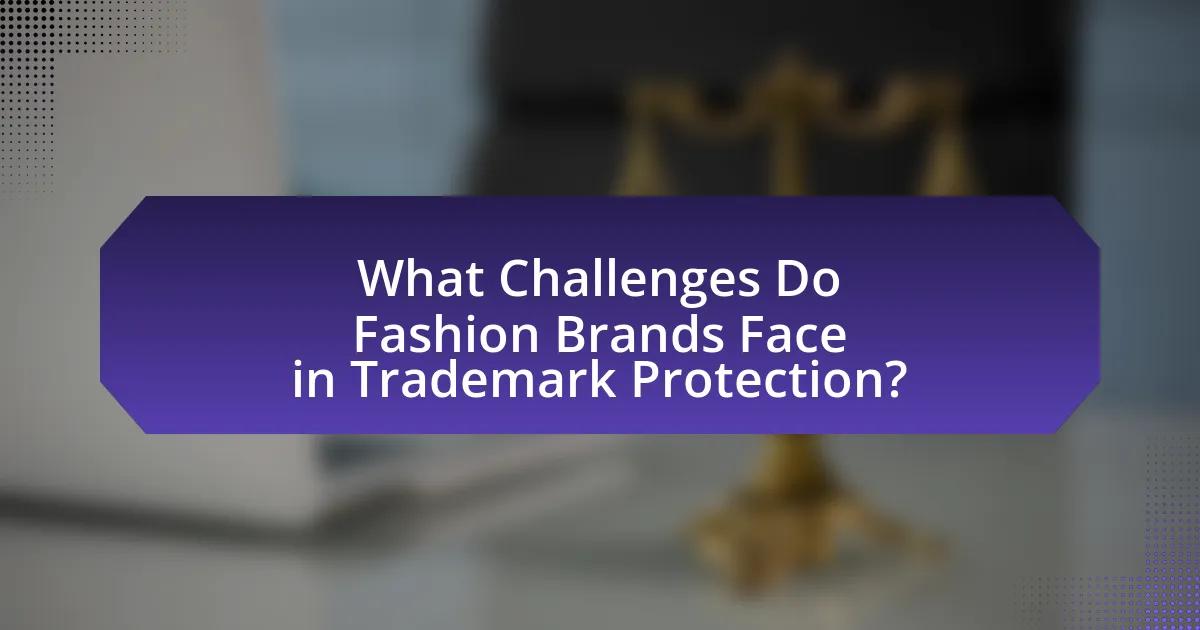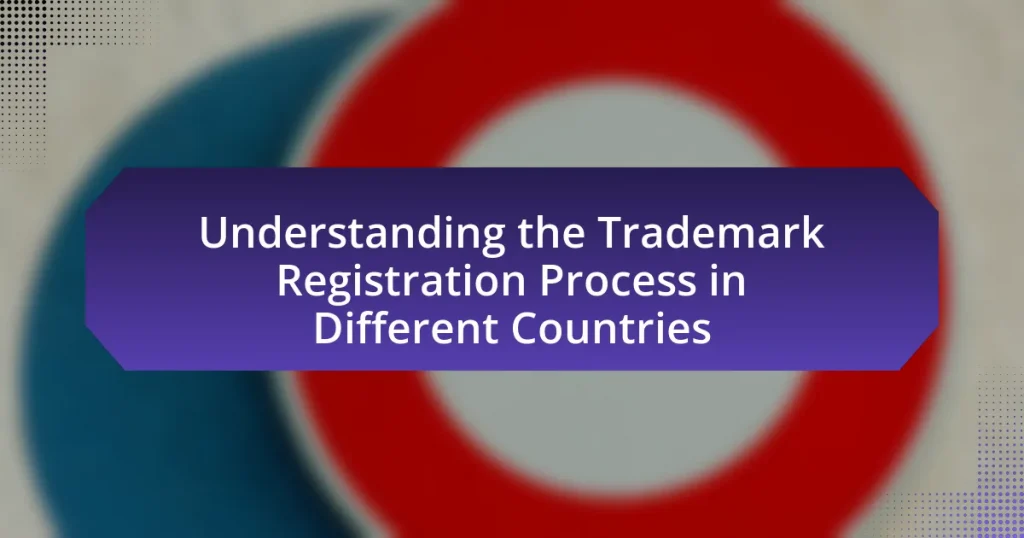Trademark law in the fashion industry is a legal framework that safeguards brand identifiers such as names, logos, and unique designs, ensuring that designers can protect their intellectual property from unauthorized use. This article explores the significance of trademark law, detailing how it prevents brand dilution and consumer confusion, and highlights the key principles relevant to fashion, including distinctiveness and non-functionality. It also examines the differences between trademarks and other forms of intellectual property, the registration process, and the challenges faced by fashion brands in protecting their trademarks globally. Additionally, the article discusses strategies for monitoring and enforcing trademark rights, emphasizing the importance of consumer education regarding trademark protection.

What is Trademark Law in the Context of the Fashion Industry?
Trademark law in the context of the fashion industry refers to the legal framework that protects brand names, logos, and other identifiers that distinguish fashion products. This law enables designers and brands to secure exclusive rights to their trademarks, preventing unauthorized use by competitors and helping consumers identify the source of goods. For instance, the Lanham Act in the United States provides the basis for trademark protection, allowing fashion brands to register their trademarks and enforce their rights against infringement. This legal protection is crucial in a highly competitive market, where brand identity significantly influences consumer purchasing decisions.
How does Trademark Law protect unique designs in fashion?
Trademark Law protects unique designs in fashion by allowing designers to register distinctive marks associated with their products, which can include logos, brand names, and even specific design elements that signify the source of the goods. This legal framework prevents others from using similar marks that could cause confusion among consumers, thereby safeguarding the designer’s brand identity and market position. For instance, the Lanham Act in the United States provides the basis for trademark protection, enabling designers to enforce their rights against unauthorized use of their trademarks, which can include pursuing legal action for infringement. This protection is crucial in the fashion industry, where brand recognition and consumer loyalty are heavily influenced by unique design elements.
What are the key principles of Trademark Law relevant to fashion?
The key principles of Trademark Law relevant to fashion include distinctiveness, non-functionality, and likelihood of confusion. Distinctiveness ensures that a trademark can identify and distinguish the source of goods, which is crucial for fashion brands to protect their unique designs and logos. Non-functionality prohibits the protection of features that are essential to the use or purpose of the product, ensuring that functional aspects of fashion items cannot be trademarked. Likelihood of confusion assesses whether consumers might mistakenly believe that goods come from the same source, which is vital for preventing brand dilution and protecting consumer interests. These principles collectively safeguard the identity and integrity of fashion brands in a competitive market.
How do trademarks differ from other forms of intellectual property in fashion?
Trademarks differ from other forms of intellectual property in fashion primarily by protecting brand identifiers such as logos, names, and slogans, rather than the designs or inventions themselves. While patents safeguard new inventions and designs for a limited time, and copyrights protect original artistic works, trademarks focus on distinguishing goods and services in the marketplace. For instance, the trademark of a fashion brand like Nike not only identifies the source of the products but also signifies the brand’s reputation and quality, which is crucial in the competitive fashion industry. This distinction is vital as it allows consumers to make informed choices based on brand recognition, thereby enhancing brand loyalty and market differentiation.
Why is Trademark Law essential for fashion designers?
Trademark law is essential for fashion designers because it protects their brand identity and unique designs from unauthorized use. By registering trademarks, designers can legally prevent others from using similar marks that could confuse consumers, thereby safeguarding their reputation and market position. For instance, the fashion industry is highly competitive, and a strong trademark can enhance brand recognition, leading to increased sales and customer loyalty. According to a study by the International Trademark Association, 83% of consumers indicated that they would be less likely to purchase a product if they believed it was counterfeit, highlighting the importance of trademark protection in maintaining brand integrity and consumer trust.
What risks do designers face without trademark protection?
Designers face significant risks without trademark protection, including the potential for brand dilution, loss of market share, and increased competition from counterfeit products. Without trademark protection, a designer’s unique creations can be easily copied, leading to a lack of differentiation in the marketplace. This can result in diminished brand value and consumer confusion, as customers may struggle to identify the original source of a design. Additionally, the absence of legal recourse against infringers can lead to financial losses, as designers may find it challenging to compete against cheaper, unauthorized replicas. According to a study by the International Trademark Association, 70% of businesses reported that trademark infringement negatively impacted their revenue, highlighting the critical importance of trademark protection for maintaining a designer’s competitive edge and brand integrity.
How can trademarks enhance a brand’s value in the fashion industry?
Trademarks enhance a brand’s value in the fashion industry by providing legal protection for unique identifiers such as logos, names, and designs, which helps to establish brand recognition and consumer loyalty. This legal protection prevents unauthorized use by competitors, thereby safeguarding the brand’s reputation and market position. For instance, a study by the International Trademark Association found that brands with registered trademarks experience a 20% higher market value compared to those without, demonstrating the financial benefits of trademark protection. Additionally, strong trademarks can lead to increased consumer trust and perceived quality, further elevating a brand’s status in a competitive market.

What Types of Trademarks are Commonly Used in Fashion?
The types of trademarks commonly used in fashion include word marks, design marks, and trade dress. Word marks protect brand names and slogans, such as “Nike” or “Just Do It,” while design marks safeguard logos and symbols, like the iconic swoosh. Trade dress refers to the overall visual appearance of a product or its packaging, which can include color schemes and design elements that signify the source of the product, such as the unique shape of a bottle or the layout of a store. These trademarks are essential for distinguishing brands in a competitive market and protecting intellectual property rights.
What are the different categories of trademarks applicable to fashion brands?
The different categories of trademarks applicable to fashion brands include word marks, design marks, trade dress, service marks, and collective marks. Word marks protect brand names and slogans, while design marks safeguard logos and unique visual elements. Trade dress refers to the overall appearance and packaging of a product, which can include color schemes and shapes that signify the source of the goods. Service marks are similar to trademarks but apply to services rather than goods. Collective marks are used by members of a collective group to indicate membership and shared characteristics. These categories help fashion brands protect their identity and distinguish their products in a competitive market.
How do logos and brand names serve as trademarks in fashion?
Logos and brand names serve as trademarks in fashion by providing distinct identifiers that differentiate products and establish brand recognition. These trademarks protect the intellectual property of fashion brands, ensuring that consumers can easily identify the source of goods and services. For instance, the Nike swoosh and the Chanel double C logo are legally protected trademarks that signify quality and authenticity, preventing unauthorized use by competitors. Trademark law, as outlined in the Lanham Act, grants exclusive rights to these identifiers, allowing brands to take legal action against infringement, thereby safeguarding their reputation and market position.
What role do trade dress and packaging play in trademark protection?
Trade dress and packaging serve as critical components of trademark protection by distinguishing a brand’s products from those of competitors. Trade dress refers to the visual appearance of a product or its packaging that signifies the source of the product to consumers. This includes elements such as shape, color, design, and overall presentation. For instance, the unique packaging of a luxury handbag can be protected under trade dress if it is non-functional and has acquired distinctiveness, meaning consumers associate it specifically with that brand.
The legal framework for protecting trade dress is established under the Lanham Act, which allows businesses to prevent others from using similar trade dress that could cause confusion among consumers. A notable case is the 2013 Supreme Court decision in Wal-Mart Stores, Inc. v. Samara Brothers, Inc., which affirmed that trade dress can be protected if it is inherently distinctive or has acquired secondary meaning. This protection is vital in the fashion industry, where unique designs and packaging can significantly influence consumer purchasing decisions and brand loyalty.
How can fashion designers register their trademarks?
Fashion designers can register their trademarks by filing an application with the United States Patent and Trademark Office (USPTO) or the relevant trademark authority in their country. The process involves selecting a unique mark, conducting a trademark search to ensure it is not already in use, completing the application form, and paying the required fees. According to the USPTO, a registered trademark provides legal protection and exclusive rights to the designer, preventing others from using a similar mark in a way that could cause confusion.
What steps are involved in the trademark registration process?
The trademark registration process involves several key steps: conducting a trademark search, filing an application, examination by the trademark office, publication for opposition, and finally, registration.
First, conducting a trademark search ensures that the desired trademark is not already in use or registered by another entity, which helps avoid potential legal conflicts. Next, filing an application with the relevant trademark office includes providing necessary details about the trademark and its intended use. After submission, the trademark office examines the application to assess compliance with legal requirements and potential conflicts. Following examination, the trademark is published for opposition, allowing third parties to contest the registration if they believe it infringes on their rights. If no opposition is filed or if opposition is resolved, the trademark is registered, granting the owner exclusive rights to use the mark in commerce.
These steps are essential for securing trademark protection, which is crucial for maintaining brand identity and preventing unauthorized use in the fashion industry.
What are the costs and timelines associated with trademark registration?
The costs associated with trademark registration typically range from $225 to $400 per class of goods or services in the United States, depending on the filing method chosen. The timeline for trademark registration can vary, but it generally takes about 8 to 12 months from the initial application submission to receive a registration, assuming no objections or oppositions arise during the process. This timeframe is supported by the United States Patent and Trademark Office (USPTO), which outlines that the examination process and potential responses to office actions can extend the duration of registration.

What Challenges Do Fashion Brands Face in Trademark Protection?
Fashion brands face significant challenges in trademark protection, primarily due to the high volume of counterfeit products and the difficulty in proving distinctiveness. The fashion industry is particularly vulnerable to imitation, as designs can be easily replicated, leading to brand dilution. Additionally, the global nature of fashion markets complicates enforcement, as trademark laws vary by country, making it hard for brands to protect their intellectual property consistently. According to a report by the International Trademark Association, counterfeiting costs the fashion industry billions annually, highlighting the urgent need for effective trademark strategies.
What common infringements occur in the fashion industry?
Common infringements in the fashion industry include trademark infringement, copyright infringement, and design patent infringement. Trademark infringement occurs when a brand uses a logo or name that is confusingly similar to another established brand, leading to consumer confusion. Copyright infringement happens when a designer copies original artistic works, such as prints or patterns, without permission. Design patent infringement involves the unauthorized use of a patented design, which protects the ornamental aspects of a product. These infringements undermine the intellectual property rights of designers and brands, impacting their market position and profitability.
How can counterfeit products impact legitimate fashion brands?
Counterfeit products significantly undermine legitimate fashion brands by diluting their brand value and eroding consumer trust. When consumers unknowingly purchase counterfeit items, they may associate the poor quality of these fakes with the legitimate brand, leading to a negative perception. According to a report by the Organization for Economic Cooperation and Development (OECD), the global trade in counterfeit and pirated goods was valued at nearly $509 billion in 2016, illustrating the scale of the issue and its potential to harm legitimate businesses. Furthermore, counterfeit products can lead to substantial financial losses for authentic brands, with estimates suggesting that the fashion industry loses billions annually due to counterfeiting. This financial impact, combined with the reputational damage, creates a challenging environment for legitimate fashion brands striving to maintain their unique designs and market position.
What legal actions can brands take against trademark infringement?
Brands can take several legal actions against trademark infringement, including filing a lawsuit for damages, seeking injunctive relief to stop the infringing activity, and requesting the seizure of counterfeit goods. When a brand identifies unauthorized use of its trademark, it can initiate a civil lawsuit in federal or state court, where it may seek monetary damages for losses incurred due to the infringement. Additionally, brands can request a court order to prevent further use of the trademark, which is known as injunctive relief. Furthermore, under the Lanham Act, brands have the right to seek the seizure and destruction of counterfeit goods, reinforcing their trademark rights and protecting their brand identity. These actions are supported by legal precedents that affirm the importance of trademark protection in maintaining brand integrity and consumer trust.
How do international trademark laws affect global fashion brands?
International trademark laws significantly impact global fashion brands by providing legal protection for their unique designs and brand identities across different jurisdictions. These laws enable fashion brands to register trademarks in multiple countries, safeguarding their logos, names, and distinctive designs from unauthorized use or imitation. For instance, the Madrid Protocol allows brands to file a single application to protect their trademarks in multiple member countries, streamlining the process and reducing costs. This legal framework is crucial for maintaining brand integrity and consumer trust, as it helps prevent counterfeiting and brand dilution, which are prevalent issues in the fashion industry. According to the World Intellectual Property Organization, the global fashion industry loses billions annually due to counterfeit goods, underscoring the importance of robust trademark protections in preserving brand value and market position.
What are the differences in trademark protection across various countries?
Trademark protection varies significantly across countries, influenced by local laws, enforcement mechanisms, and international treaties. For instance, the United States employs a “first to use” system, granting rights to the first party to use a trademark in commerce, while many European countries follow a “first to file” system, where registration is crucial for obtaining rights. Additionally, countries like China have been known for their strict enforcement of trademark rights, often favoring local businesses in disputes, whereas countries in the European Union provide a more harmonized approach through the EU Trademark Regulation, allowing for broader protection across member states. These differences can impact how fashion brands protect their unique designs, with varying levels of legal recourse available depending on the jurisdiction.
How can fashion brands navigate international trademark disputes?
Fashion brands can navigate international trademark disputes by conducting thorough trademark searches and registering their trademarks in key markets. This proactive approach helps identify potential conflicts and secures legal protection for their unique designs. Additionally, brands should engage local legal experts familiar with the trademark laws of the countries they operate in, as these laws can vary significantly. For instance, the Madrid Protocol allows brands to file for trademark protection in multiple countries simultaneously, streamlining the process. Furthermore, brands should monitor the market for potential infringements and be prepared to enforce their rights through legal action if necessary, as seen in cases like the Gucci vs. Guess dispute, where proactive enforcement helped protect brand integrity.
What Best Practices Should Fashion Designers Follow for Trademark Protection?
Fashion designers should register their trademarks with the United States Patent and Trademark Office (USPTO) to ensure legal protection of their brand identity. This registration provides exclusive rights to use the trademark in commerce, which helps prevent unauthorized use by competitors. Additionally, designers should conduct thorough trademark searches to ensure their chosen marks do not infringe on existing trademarks, thereby avoiding potential legal disputes. Regular monitoring of the marketplace for unauthorized use of their trademarks is also essential, as it allows designers to take timely action against infringement. Furthermore, designers should maintain proper documentation of their design processes and marketing materials to establish ownership and the distinctiveness of their trademarks. These practices are supported by the fact that registered trademarks can significantly enhance brand value and consumer recognition, as evidenced by the success of well-known fashion brands that have effectively protected their trademarks.
How can designers effectively monitor and enforce their trademarks?
Designers can effectively monitor and enforce their trademarks by implementing a combination of proactive monitoring strategies and legal actions. Proactive monitoring includes regularly searching online marketplaces, social media platforms, and industry publications for unauthorized use of their trademarks. Tools such as trademark watch services can automate this process, alerting designers to potential infringements.
When infringement is detected, designers should take immediate legal action, which may involve sending cease-and-desist letters or filing lawsuits to protect their rights. According to the International Trademark Association, timely enforcement is crucial, as delays can weaken a trademark’s validity. Additionally, registering trademarks with the United States Patent and Trademark Office provides legal advantages, including the ability to pursue damages in court and the presumption of ownership.
By combining vigilant monitoring with swift legal enforcement, designers can safeguard their trademarks effectively.
What strategies can be employed to educate consumers about trademark rights?
To educate consumers about trademark rights, strategies such as awareness campaigns, educational workshops, and digital resources can be employed. Awareness campaigns can utilize social media platforms to disseminate information about the importance of trademarks and how they protect brands, which is crucial in the fashion industry where unique designs are often at risk of infringement. Educational workshops can be organized in collaboration with legal experts to provide consumers with a deeper understanding of trademark laws and their implications. Additionally, creating digital resources like informative websites or mobile applications can offer easy access to information about trademark rights, including guidelines on how to identify and report potential infringements. These strategies are effective as they leverage multiple channels to reach a broad audience, ensuring that consumers are well-informed about their rights and the significance of trademarks in protecting unique designs.



